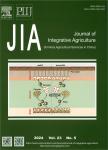Response of carbon footprint to plastic film mulch application in spring maize production and mitigation strategy
Response of carbon footprint to plastic film mulch application in spring maize production and mitigation strategy作者机构:Institute of Environment and Sustainable Development in AgricultureChinese Academy of Agricultural SciencesBeijing 100081P.R.China Institute for SoilWater and Environmental SciencesAgricultural Research Organization(ARO)Volcani Research CenterBet Dagan 50250Israel
出 版 物:《Journal of Integrative Agriculture》 (农业科学学报(英文版))
年 卷 期:2021年第20卷第7期
页 面:1933-1943页
核心收录:
基 金:supported by the National Natural Science Foundation of China (31901477, 31871575 and 3191101554) the Central Public Interest Scientific Institution Basal Research Fund Institute of Environment and Sustainable Development in Agriculture, Chinese Academy of Agricultural Sciences (BSRF201909)
主 题:carbon footprint greenhouse gas plastic film maize
摘 要:Producing more food with a lower environmental cost is one of the most crucial challenges worldwide. Plastic mulching has developed as one of the most dominant practices to improve crop yields, however its impacts on greenhouse gas(GHG) emissions during the production life cycle of a crop are still unclear. The objective of this work is to quantify the impacts of plastic film on GHG emissions and to reduce GHG emissions with innovative agronomic practices. Carbon footprint per unit of area(CFa), per unit of maize grain yield(CFy), and per unit of economic output(CFe) were evaluated for three maize cultivation systems: a no mulch system, a conventional plastic mulching system(PM) and a biennial plastic mulching pattern, namely a ’one film for 2 years’ system(PM2), during 2015–2018 in a maize field located on the Loess Plateau of China. The results suggested that PM induced a 24% improvement in maize yields during the four experimental years compared to a no-mulch treatment(NM). However, PM dramatically increased the CFa by 69%, 59% of which was created by the input of the plastic film material, and 10% was created by increases in the soil N2O emissions. The yield improvements from PM could not offset the increases in CFa, and CFy and CFe were both increased by 36%. Shifting from PM to PM2 did not reduce crop yields, but it led to a 21% reduction in CFa and 23% reductions in CFy and CFe due to the reduced input amount of plastic film, decreased soil N2O emissions, and less diesel oil used for tillage. Compared to NM, CFy and CFe were only 5% higher in PM2. This study highlights the necessity of reducing the amount of plastic film input in the development of low-carbon agriculture and shifting from conventional PM cultivation to PM2 could be an efficient option for mitigating GHG emissions while sustaining high crop yields in plastic mulched fields.



